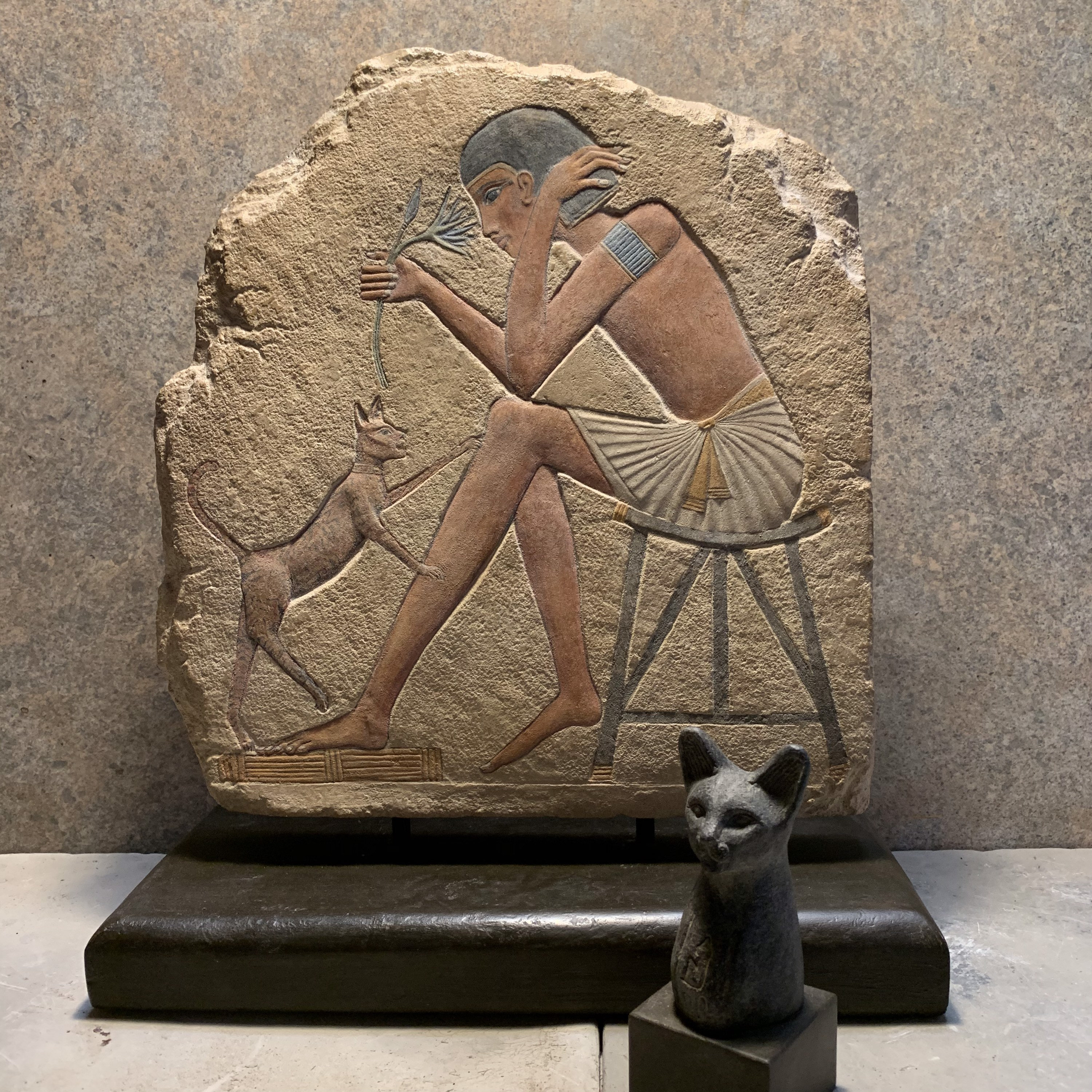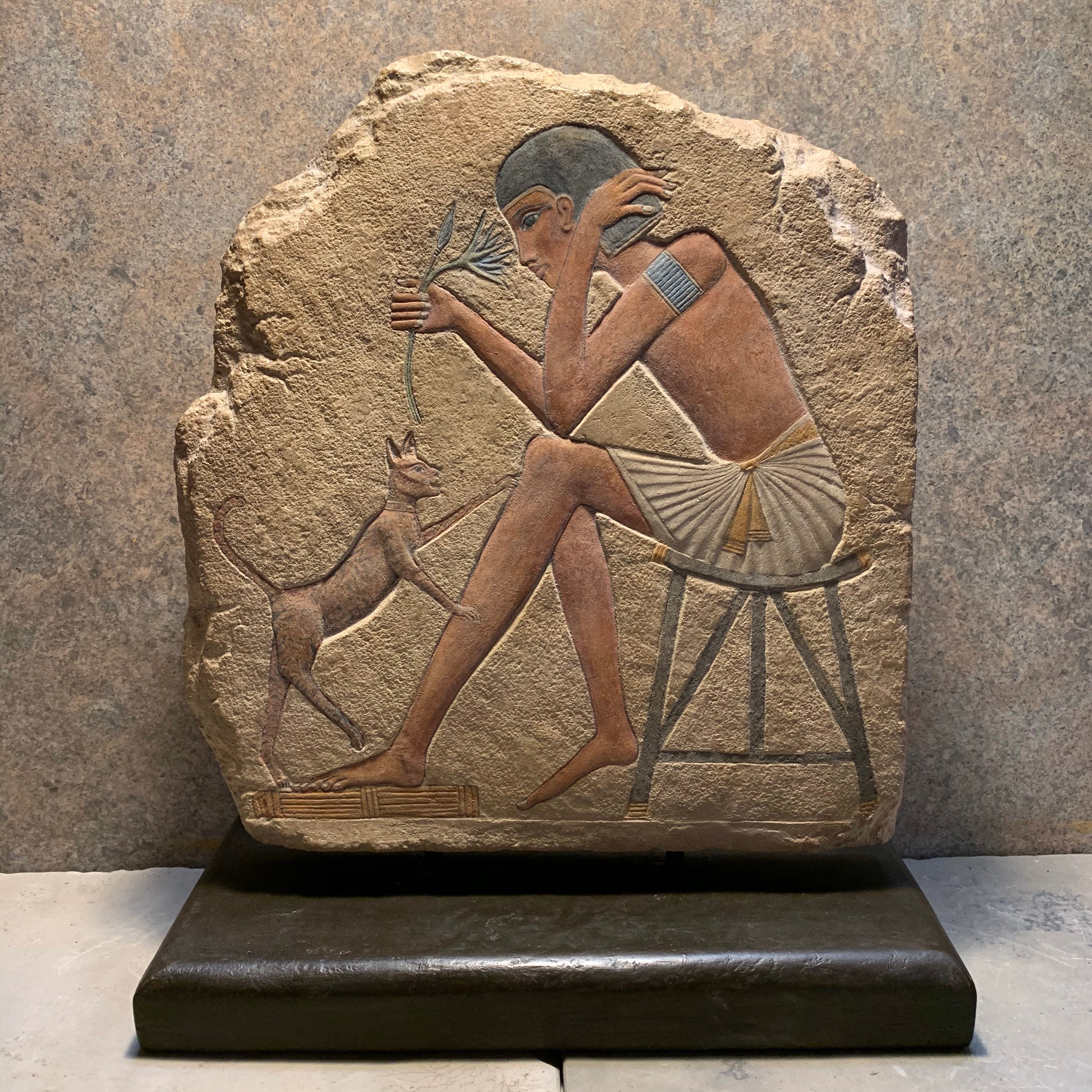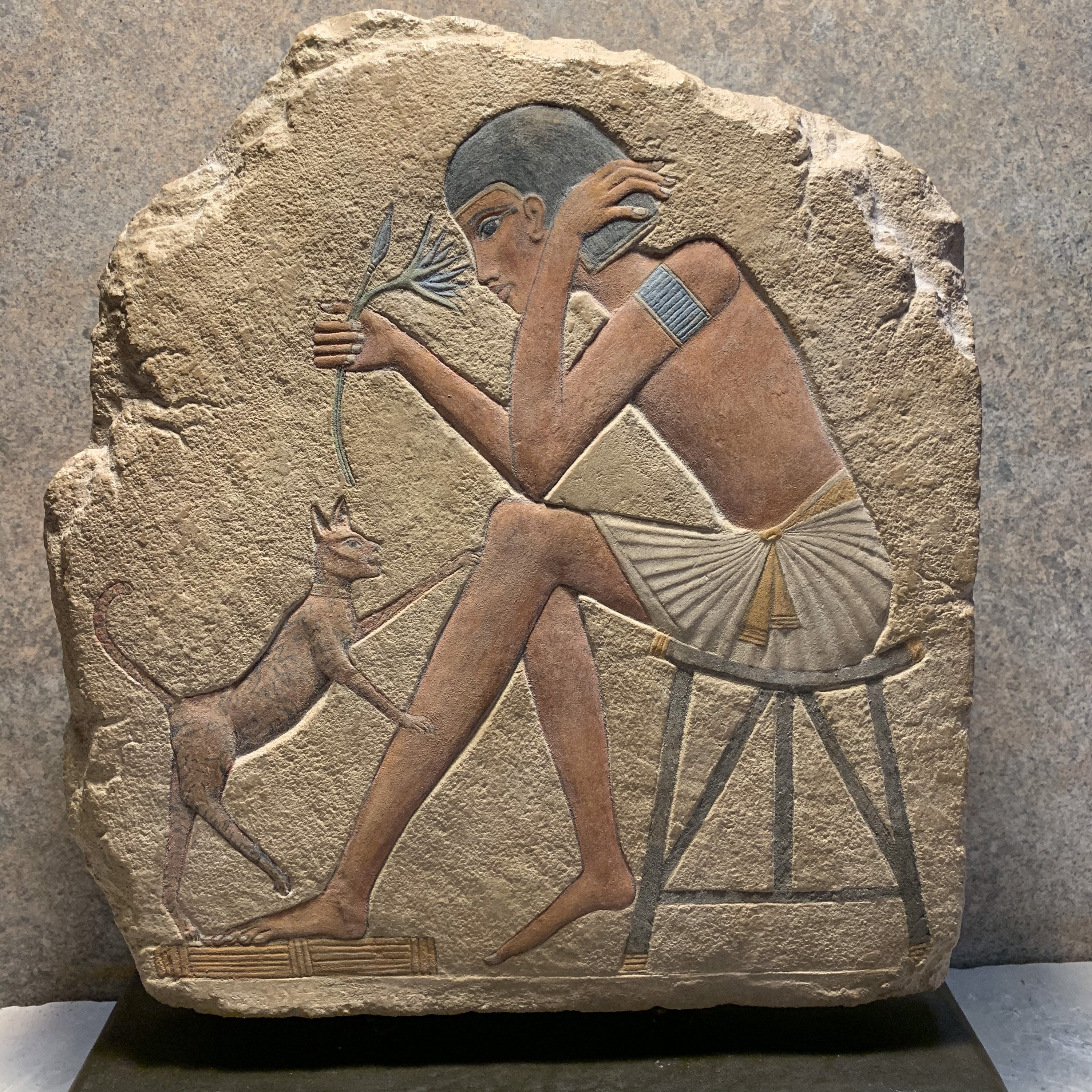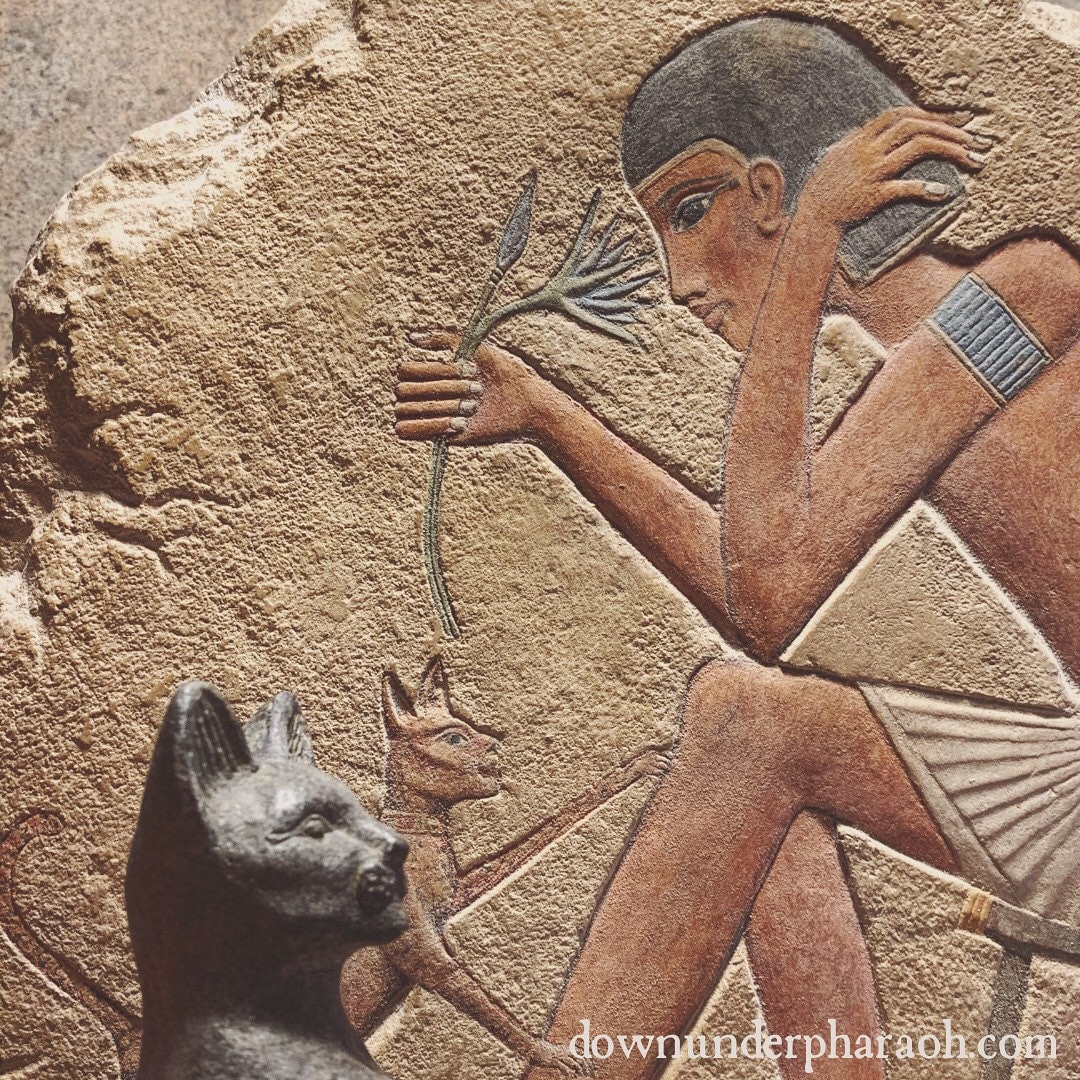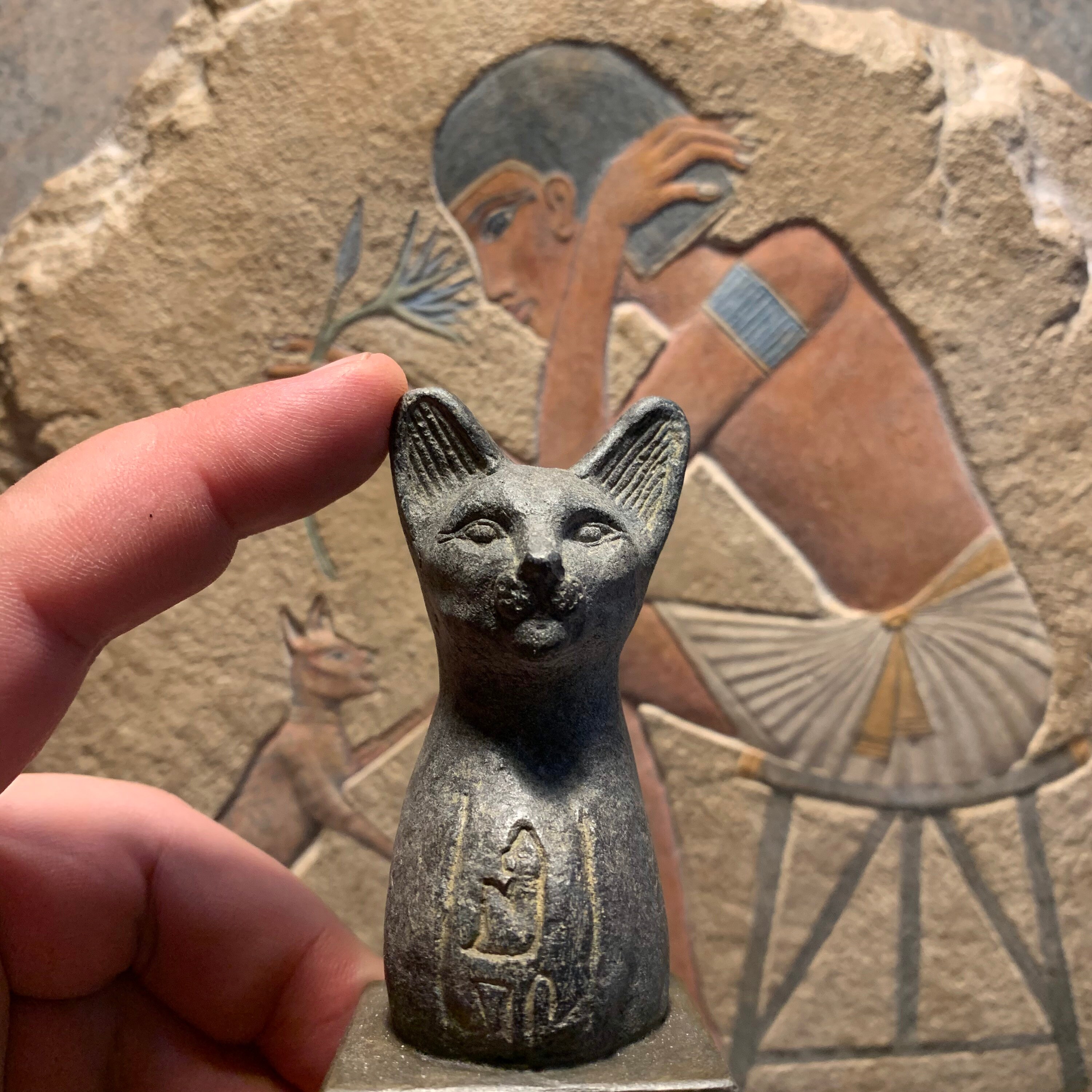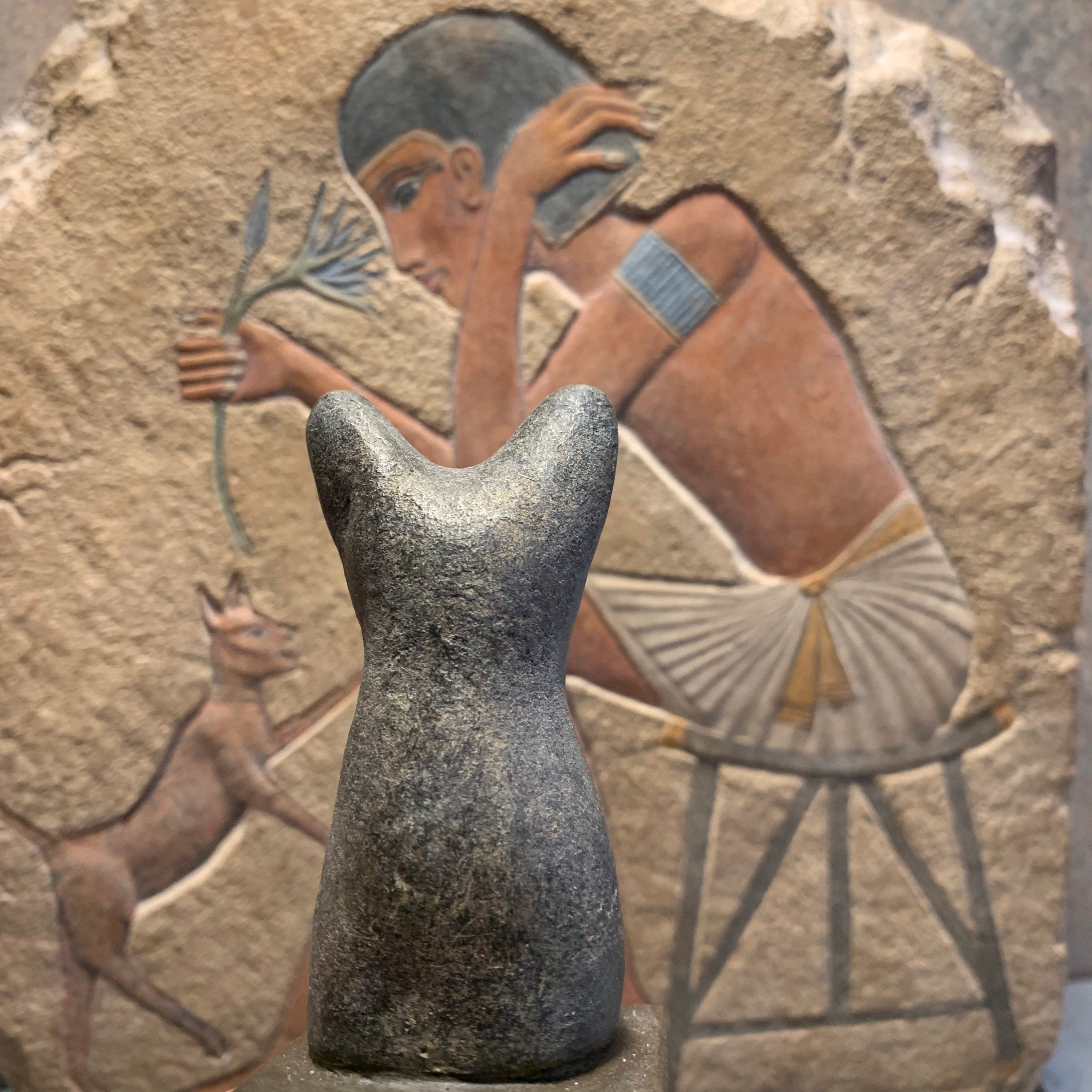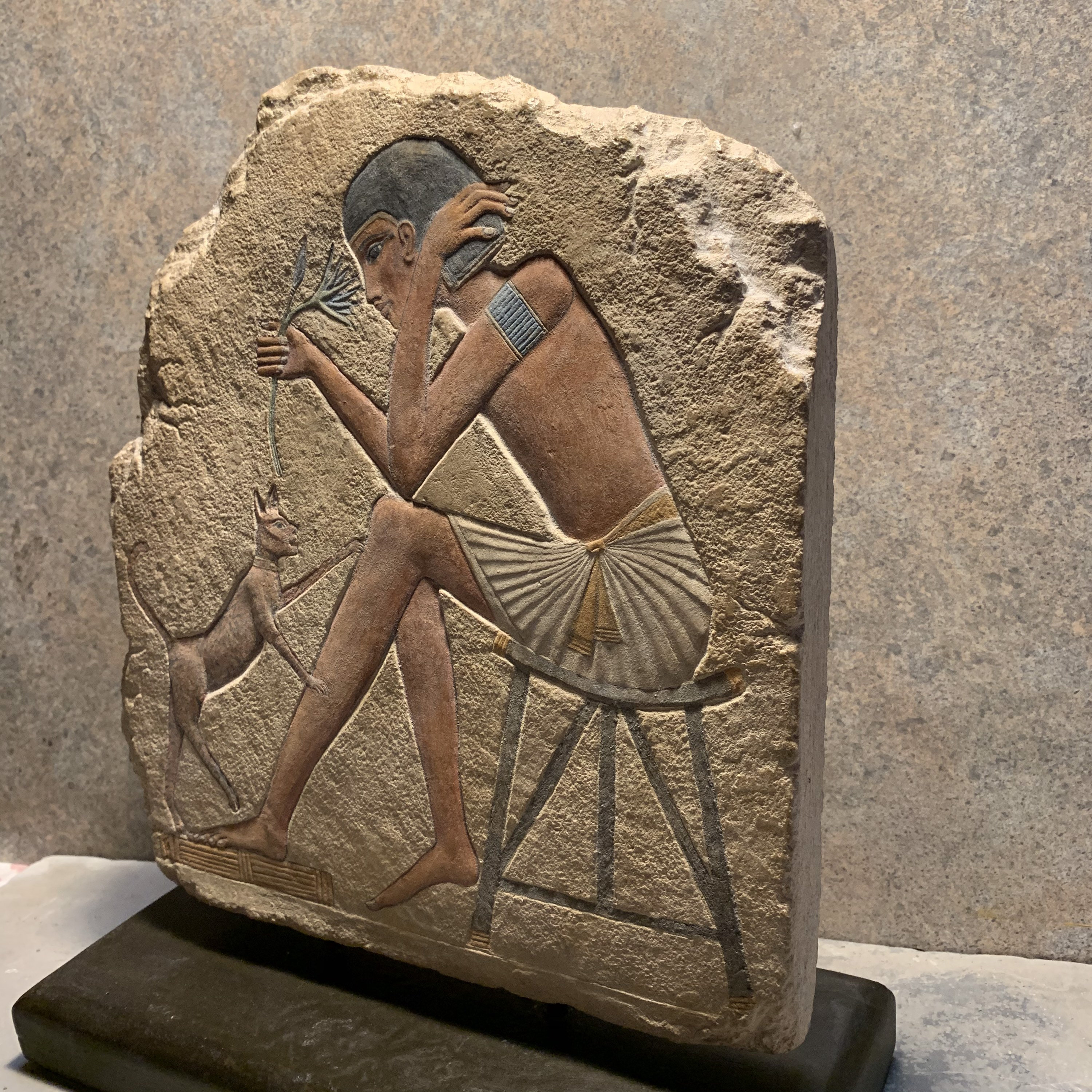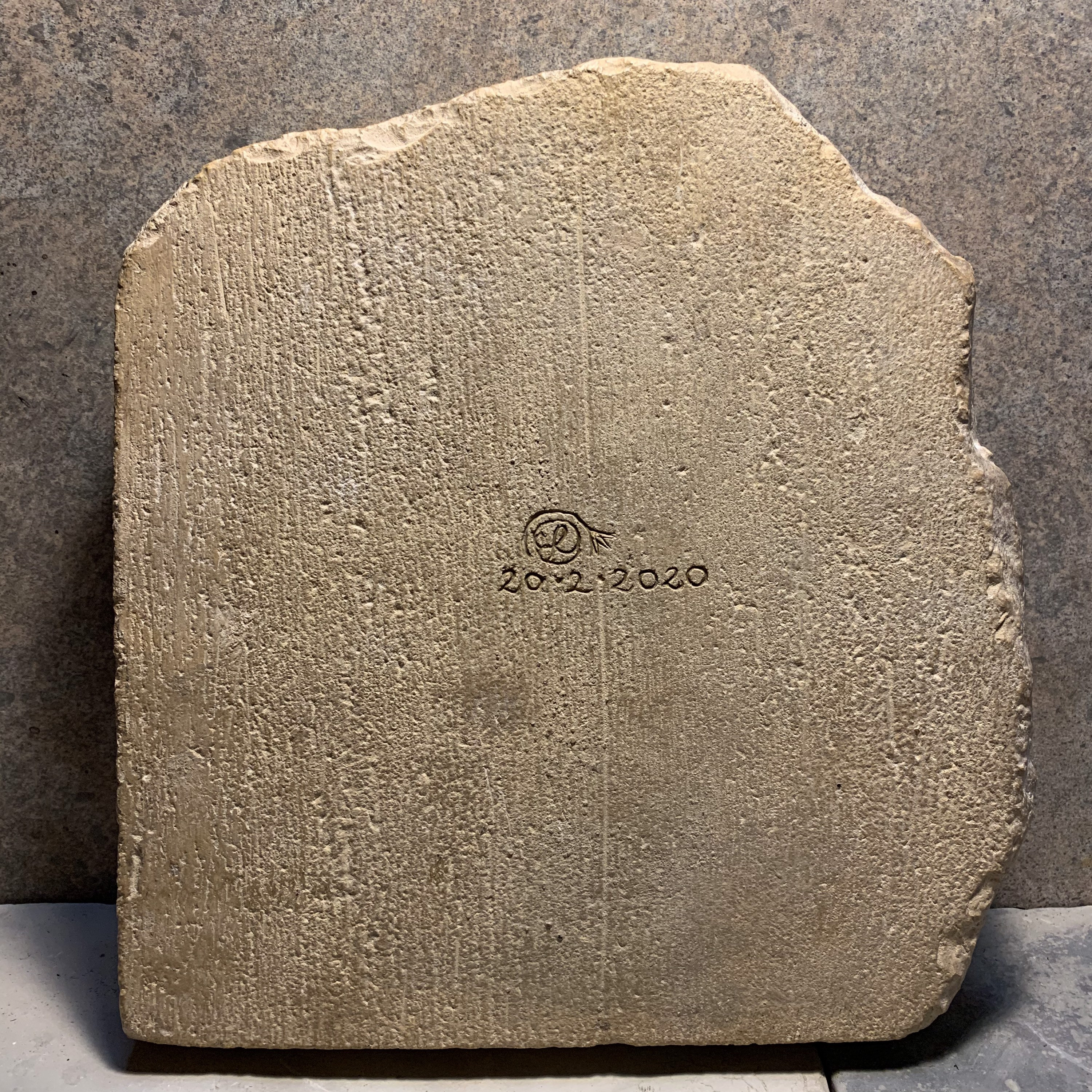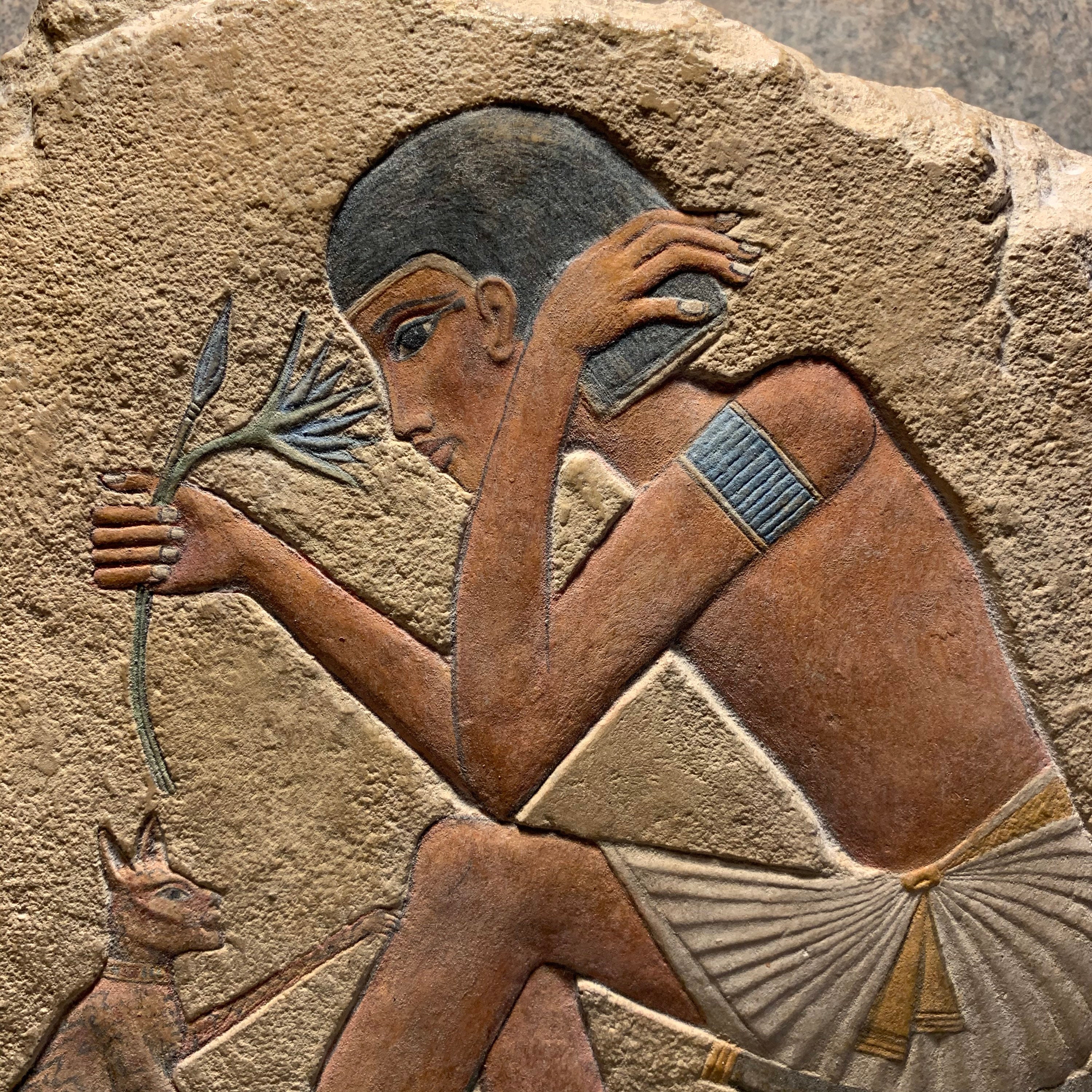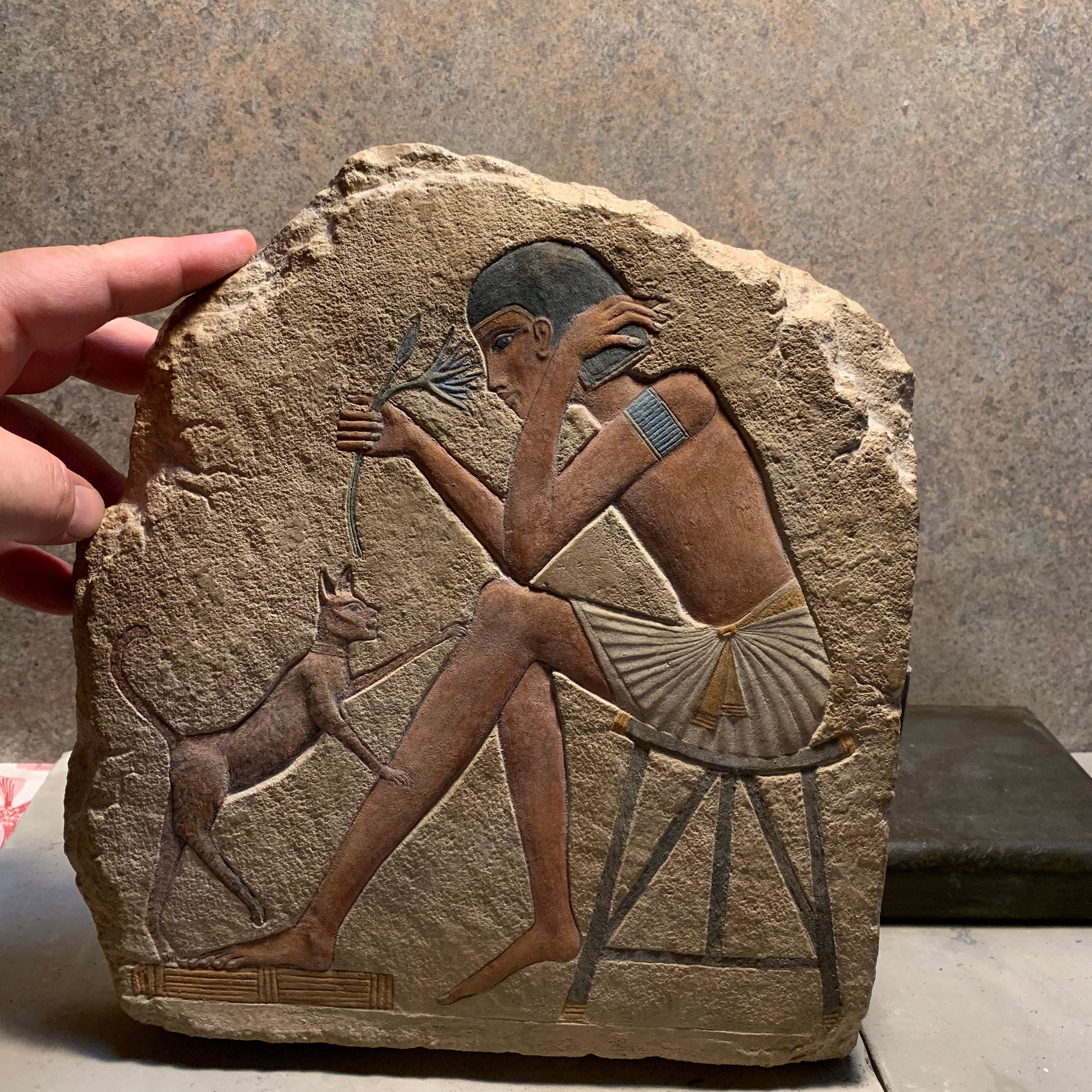Egyptian art / statue & relief sculpture Bast cat - Tadukhippa and the sculptor
$173.34
Bast cat - Tadukhippa & the sculptor
Presently this artwork will be made to order by your request. Allow approximately 2 weeks for completion.
Dimensions of mounted fragment :-
Height - 32 cm / 12-1/2 inches
Base length - 26 cm / 10-1/4 inches
Width - 11.5 cm / 4-1/2 inches
Dimensions of Bast statue :-
Height - 10.2 cm / 4 inches
Base stand - 4 x 4 cm / 1-3/4 inches square approximately.
* International customers, please forward your post / zip code so we can offer you the best possible postage cost. Combined rates are also offered.
On offer here - a painted relief sculpture and a replica Bast statue that I designed for my cat when she was alive. The relief is a piece that is a more personal art work created in an Egyptian style to commemorate my last and most special cat.
Made of a limestone and quartzite composition stone, the hand painted details enliven the fragment with traditional Egyptian colours. This signed edition is mounted on a removable, polished, felt lined stand.
* The background information that follows go some way towards describing the early period leading up to the carving itself.
For more visuals relating to the early work mentioned below, Down under Pharaoh on youtube and instagram provide some interesting archival viewing.
Background information
Her name was Tadukhippa or Kippa for short. An obscure name in the long hall of Egyptian history but one associated with the reign of Amenhotep III.
Along with Gilukhippa these unusual names have a likely Mittanian origin and were the names of foreign princesses sent to the Pharaoh to live in the most cosmopolitan court of the ancient world at that time.
Some theories suggest Nefertiti and Tadukhippa were one and the same person but I no longer subscribe to that view anymore. I did at the time however when Kippa the cat entered my life.
It was winter 1990 when I met Tadukhippa. I was living as a student in Brisbane, studying graphic design but supporting myself with my carvings.
I had placed an over life sized trial sculpture of a Pharaoh's head on a tree stump in the leafy back yard. It was black stone and could hardly be seen in the dark undergrowth of the dense mock orange foliage.
I was in the middle of hanging out the washing when suddenly a rustle in the bushes near the sculpture caught my attention. Out jumped this most spritely and beautiful tortoise shell cat and she decided to come straight over and own me. Certainly not the first time this had happened as other stray cats and dogs would wander in and out of our lives when I lived on a remote farm as a child.
After several weeks of visitation it was obvious that this random cat was another stray and had taken up residence.
She became my muse for some artistic endeavours both Egyptian & my own developing style. I sketched, I painted and sculpted her and replicas of some of her earliest portraits from that period can be seen in store from time to time.
She was the most affectionate cat I had ever known. Quirky and much loved, her death was premature as a friend accidently ran into her with a 4 wheel drive.
She died in my arms.
A year later I made this relief carving as a kind of homage to her memory in 1999.
The classic years - 1983 - 1998
All pets up until the time of Kippa's death were buried on my Grandparents remote property within what is known as the 'scenic rim', an ancient volcanic area with fantastic gnarled and eroded mountains that could be seen from every angle, curving on the horizon like an embrace.
This was the land of my youth and where I learnt to carve the rocks. It was to become my little kingdom of Egypt. Not far from my grandparents house at age 12, I built two isolated stone structures that looked like small ruined buildings in Deir el medina - the workmans village in the foot hills of ancient Thebes. I called it Nagada 1 & 2. A nod to the earliest Egyptian settlements along the Nile valley.
Sitting within the 3 ft high dry stone walls I carved a piece that is now my oldest surviving stone carving. An earlier piece exists, but was submerged when a creek was dammed on our own farm. Just like the fate of the Nubian temple of Gerf Husein i thought.
As I got older and more confident to travel further afield amidst snakes and scorpions, I came upon an eroded gully which I named the 'Valley of the Kings'. Complete with 'Agatha Christie's pass' it was the true cradle of my Egyptian creativity and I absolutely loved going to work there. The greatest repository of sandstone existed in this isolated place.
Agatha Christie actually stayed across the road in Coochin homestead in the 1920's when she went 'missing'. I found this quite inspirational. Egyptian themes were woven into some of her work and the novel 'Death becomes her' an early classic of ancient Egyptian imagery.
So there i was making small 'temples' and workshops assembled out of the natural sandstone in this area. Tombs were made for special budgies and goldfish cut into the sandstone to create little rooms and sealed with mud, plaster and choice flat stones. Rough made structures were springing up everywhere on the property. Mostly uncut stone but some were naturally brick like and were used for casings or exterior walls.
I was 15 years old in 1986 during this period when I began to learn and carve hieroglyphs in this area and completed my first relief sculpture. The most notable achievements of that year were three heads carved in low sandstone cliffs. It was an early, blister making rite of a sculptors passage.
I used my grandfathers wood carving tools to do the work. Not ideal instruments but that is all I had along with grinding stones found naturally. I did get into trouble about the state of their blunt condition. One day my grandfather stumbled upon these heads gleaming white in the midday sun as he rode his horse on by and reconsidered his appraisal of the tool episode with some much needed words of encouragement. The fact i was now able to transform an unasuming chunk of worn stone into something recognisable gave me great motivation.
I was in highschool during these halcyon days and works in the kingdom were done mainly during the school holidays or a random weekend.
I used to dream of these sculptures while i was away from them. How they would look in the intense light of a full moon.
Carving requires much patience.
I had a lot of fish and birds during those years. Hundreds of fish really and the inevitable deaths gave me practice in the art of mummification. All pets were mummified using a salt packing method similar to the ancient Egyptian natron method and trials of the salt bath method also attempted with mixed results. Studying biology and anatomy of animals gave me some insight into what the Egyptians had done to preserve their millions of mummified subjects.
Some of the most special pets had the royal treatment.
Small tomb, sarcophagus, one or more coffins, pots, inscriptions, stele, amulets and a carefully wrapped mummy. The more important the pet the greater the effort. One goldfish had a 5 ft pyramid made from the local stone in an area I called Memphis. That was completed on the 26th of December 1986 and to this day has not been re-opened. It has my very first Ushabti carving included in the burial equipment. Observing this this little pyramid during my last visit in 2009, has settled to become a stable pile of rocks and a habitat for many creatures that bite.
The following year Cleopatra the budgie had a slightly larger pyramid with a more generous burial positioned on a newly discovered hill about a mile away.
In 1988 it was Australia's bicentenial year and I had decided to make something special to mark the occasion. I had scoured the land for a site and settled on the highest point on the property which was a narrow spur of a hilly landscape. I was in my first Amarna phase at that point so I called it Akhetaton. Aton with an 'O' so I could draw Aton rays from the circle as opposed to the standard 'E' in 80 percent of publications.
I fell in love with this land. Utterly and totally absorbed in the landscape almost a kilometre from the central house and in full view of my bemused grandparents who wondered when I would ever grow out of this obsession.
I decided to build a third pyramid and It was going to be the biggest I could make with the natural uncut stone. Rubble in the middle, cased with the most brick like stone I could find.
I marked out the foundations and put 4 cornerstones in place. A traditional foundation deposit of a few lesser artworks were buried straight into the soil.
Building went on during every holiday and spare moment I could muster. It was soon apparent that the rock supply was not going to last and I had to travel further and further away, with nothing but a suffering wheel barrow for the flat areas and bare hands for the stone deposits gathered at the bottom of the hill. The shirt I was wearing would be stretched out to create a satchel for carrying stones up and down the hill. There were times I thought I was mad during this process but the distinct shape of a stone triangle was beginning to take shape.
Many new stone varieties revealed themselves during the collection phase. Ochre stones to make paint and a particular light grey stone that had a fine grain. This was a rare stone on the property occuring only on each side of the hill and mostly concentrated near the bottom. I would grind them flat and carve them. Both relief carving and sculpture in the round. It was a revelation and allowed far more detail than the sandstone i had previously used up until then.
At the end of 1988 the pyramid was one third complete when my cat of the era 'Shesep-ankh', an ancient name for the sphinx was found dead, likely poisoned and found near the mail box.
It happened on a Thursday and my parents wanted to bury it at once in the back yard. This I could not abide as he was the king.
I arranged with my friends to take him up to the mountains for burial and I would dismantle part of the pyramid to access the soil and bury him properly and with dignity. The bicentenial pyramid would become a tomb.
The journey on the Saturday was broken by a stop for supplies. It was a hot, late spring day and we returned to a rather fragrant car and it wasn't the flowers resting on the makeshift coffin.
We travelled a lot faster along those remote country roads for the rest of the journey.
On arrival, my grandparents were mortified that I was going to such effort for a tomcat. To me it was the logical thing to do.
After a few hours on a cloudless, balmy afternoon, a substantial hole was dug into the foundation of the pyramid and the great cat was laid to rest. Un-mummified but wrapped beautifully in great lengths of bandages. I recited a passage from the book of the dead that seemed most appropriate and flowers were thrown and incense burned in profusion.
While this innocent ritual was being undertaken, thunder on the mountains could be heard in the distance adding to the drama of the moment and to the amusement of my friends.
We looked over to the great dividing range and the most spectacular, rolling *'Indiana Jones' type clouds tumbled through the sky and blocked out the sun.
*The Indiana Jones type clouds I mention are the ones that were moving eerily above the scene featuring the 'well of souls' in the movie Raiders of the lost Ark.
Lightning and rain were soon upon us and I quickly back filled the burial and placed enough stones on top so no wild animals would dig him up in my absence. Dingoes were sometimes seen wandering like jackals in those hills.
We ended up running off the hill as the storm took over. It felt like we had angered the gods.
Oh the joy of youthful exuberance.
The pyramid was subsequently expanded with small chambers filled with artworks, inscriptions and a bottle of wine. It was completed in the summer of 89' and reached a height of almost 9ft.
Subsidiary low walled structures were made adjacent to the east side of the pyramid creating a little road and a place to camp out under the stars. Three hearths created a wonderful atmosphere at night. And there was music and there was dance and shish kebabs.
This was the heart of the empire but time was running out. By 1994 the visitations to my beloved land were becoming less and less and not by choice. I was carving full time now and time spent building ruins and burying things was rather an odd thing to do. Most of my family thought I really was a bit mad.
So it came to pass that I pushed against the tide and was soon asked to exhibit work in the city hall, the Queensland musem & various art and decorator events. The arrival of the opera Aida gave me a chance to present some of my latest Egyptian works. Warner brothers & Fox studios also commissioned many artworks for film and television. In addition to the creative side of studio work, I was offered the role of guest teacher at various schools and art camps that gave me the opportunity to pass what I had learned to another generation.
One day I was asked for an interview to be part of the nightly news in an 'on the road' type of segment. The reporter wanted to come to the regular studio and see the artworks. This studio was to me just a boring dusty shed so I gave them directions to meet me at the pyramid so they could see one of the original work areas over an hour away from the shed studio.
In one of the little side structures, the sculptor's workshop, where I had carved many an artwork I set it up once more. My true studio lived again as some of my most special pieces were taken there to be filmed amongst the ruins and the in situ pieces.
This video and others from that era can be seen on you tube as part of Down under Pharaoh's archival footage.
Living life as an ancient artist in the modern world has not been easy but it has moments of great joy and visual delight.
After those interviews I began a fourth pyramid. This time it was going to have a chamber big enough to stand in with cast stone blocks the size of Amarna period Talatat as the building material. Rubble would still be used for the core but stone supplies were limited. I managed to make about 80 blocks and marked out the foundations of what would be Tadukhippa's pyramid. She was the greatest cat ever so she had to have a tomb befitting her exhalted status so it was best to start while she was still alive and make it big. I wanted to paint and decorate a tomb.
It was not to be. My uncle who was given the land discouraged me from doing any more. Putting an end to a glorious era of fun and learning.
The land belongs to somebody else now and a fence disects my beautiful hill cutting right through the sculptors workshop. I was very upset when i saw this the last time i was there. The pyramid sitting in the middle of encrouching bushland and high grass, is now nothing more than a glorified pile of stone, truncated after a collapse of the upper apex. Some of the stones of the lower courses are still in perfect alignment just as i put them all those years ago. I wonder if someone has tried to find it's inner secrets and became discouraged by the prospect of removing all of that stone.
I have many other pieces in the archive and this one has been one I never thought I would ever release but I have been repeatedly asked to do so because of it's unique charm.
So here it is.
Shipping from Australia
Processing time
1-2 weeks
Estimated shipping times
- North America : 1 - 3 weeks
- Europe : 1 - 3 weeks
- Australia, New Zealand and Oceania : 1 - 2 weeks
- Asia Pacific : 1 - 3 weeks
- Latin America and the Caribbean : 1 - 3 weeks
- North Africa and the Middle East : 1 - 3 weeks
- Sub-Saharan Africa : 1 - 3 weeks
I'll do my best to meet these shipping estimates, but can't guarantee them. Actual delivery time will depend on the shipping method you choose.
Customs and import taxes
Buyers are responsible for any customs and import taxes that may apply. I'm not responsible for delays due to customs.
Payment Options
Returns & Exchanges
I gladly accept returns and cancellations
Just contact me within: 5 days of delivery
Ship items back to me within: 14 days of delivery
Conditions of return
Buyers are responsible for return shipping costs. If the item is not returned in its original condition, the buyer is responsible for any loss in value.

